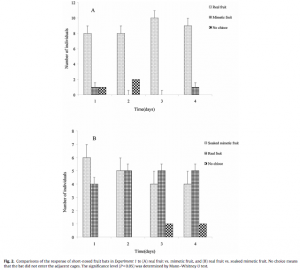The short-nosed fruit bat (Cynopterus sphinx) is a fruit-eating (frugivorous) bat that is native to south China. Like other frugivorous vertebrates, the short-nosed fruit bat faces the difficulties associated with selecting fruits and assessing their quality, which largely impacts the success of their foraging behavior. Many frugivorous vertebrates, including bats, rely on sensory cues such as olfaction, vision, and echo-information during foraging. However, since short-nosed fruit bats don’t echolocate like most other bats, and they live in complicated environments where food is often blocked by obstacles or buried in leaves and branches, these bats rely largely on their olfactory system to locate food sources and assess food quality and palatability. Olfaction is also important in the trial-and-error learning behavior of these bats, which serves to enrich their dietary sources and is particularly advantageous when food is scarce. Concurrently, trial-and-error learning plays an important role in the evolution of animal behavior.

Short-nosed fruit bat (Cynopterus sphinx)
Previous research on the short-nosed fruit bat shows that the bat is attracted by volatile substances in fruits and flowers in nature, and is able to discriminate amongst different odor compounds in complex environments. However, it is unclear how exactly the bat connects fruit odors with their corresponding fruit in a complex olfactory setting. Given that research has shown the ability of predators, such as the Wild Trachops cirrhosus bat, to learn socially about prey cues in olfactory and visual modalities, Zhang et al. (2014) tested the hypothesis that the trial-and-error behavior in short-nosed fruit bats may account for the origin of novel connections between odor cues and fruits.
Zhang et al. (2014) assessed the role of olfaction in the foraging behaviors of the short-nosed fruit bat, and explored the bats’ trial-and-error learning and memory retention associated with odor cues. In their first experiment, bats were exposed to either a real fruit and a mimetic foam fruit with no odor, or a real fruit and a mimetic foam fruit soaked in fruit juices. All real fruit and mimetic fruit were covered with gauze and thus not visible to the bats, to ensure that the bats’ responses were based solely on olfactory cues. In a second experiment, bats were trained to know correctly that fruit is always available with the odor of cedar wood oil, as they only had access to fruit that was paired with the scent of the oil. The goal of this experiment was to examine whether the connections between fruits and odor is established by learning.
The results of the first experiment showed that the short-nosed fruit bat forages based on olfactory cues, as the bats only showed a significant preference for the real fruit over the mimetic fruit when the mimetic fruit did not have an odor. In the second experiment, bats that successfully learned to choose the fruit associated with the scent of cedar wood oil were drawn to this scent even when no fruit was present, showing that they can adapt their feeding behavior to new odors in a short time. However, these bats lost their memory for cedar wood oil after an extended time period.

Responses of the short-nosed fruit bat to real fruit vs. mimetic fruit and real fruit vs. soaked mimetic fruit.
Together, these experiments show that odor may act as the primary cue for short-nosed fruit bats in finding and discriminating fruits in a close range. Additionally, the ability of the bats to remember a new odor quickly through trial-and-error learning allows them to explore and discover new food sources when their typical food sources may be limited. The fact that the bats only maintain this memory over a short period of time is important because it decreases the energy cost of memory consolidation, making this behavior evolutionarily beneficial.
References:
Zhang, W., Zhu, G., Tan, L., Yang, J., Chen, Y., Liu, Q., … & Zhang, L. (2014). Role of olfaction in the foraging behavior and trial-and-error learning in short-nosed fruit bat, Cynopterus sphinx. Behavioural processes, 103, 23-27.
